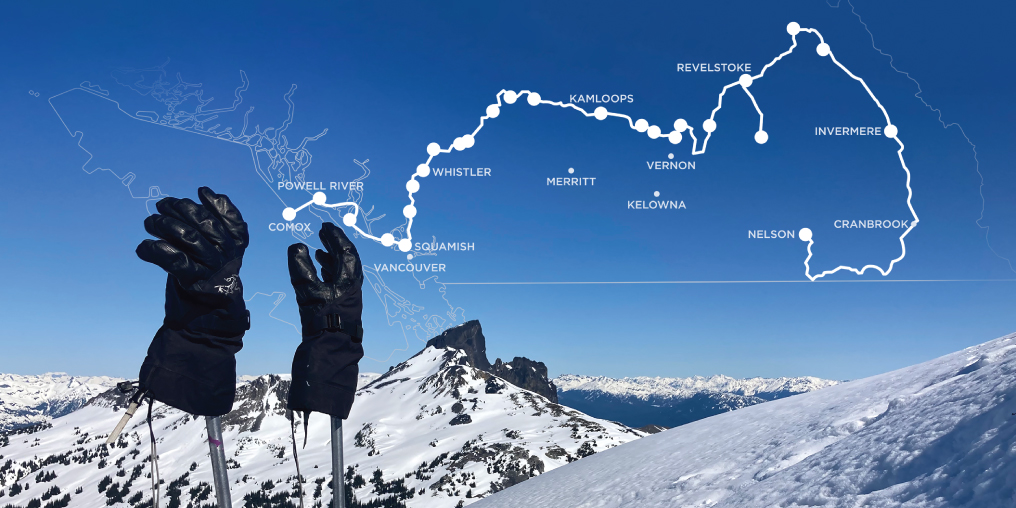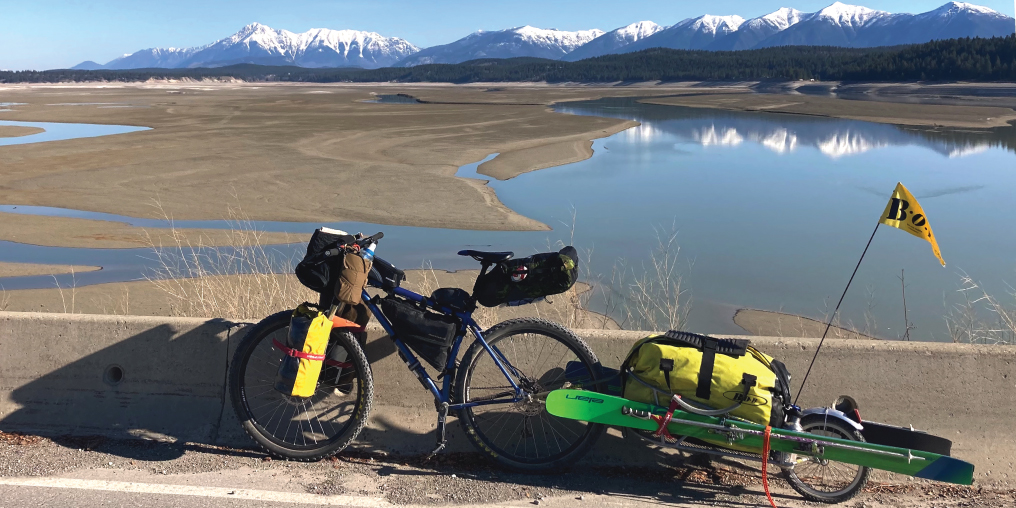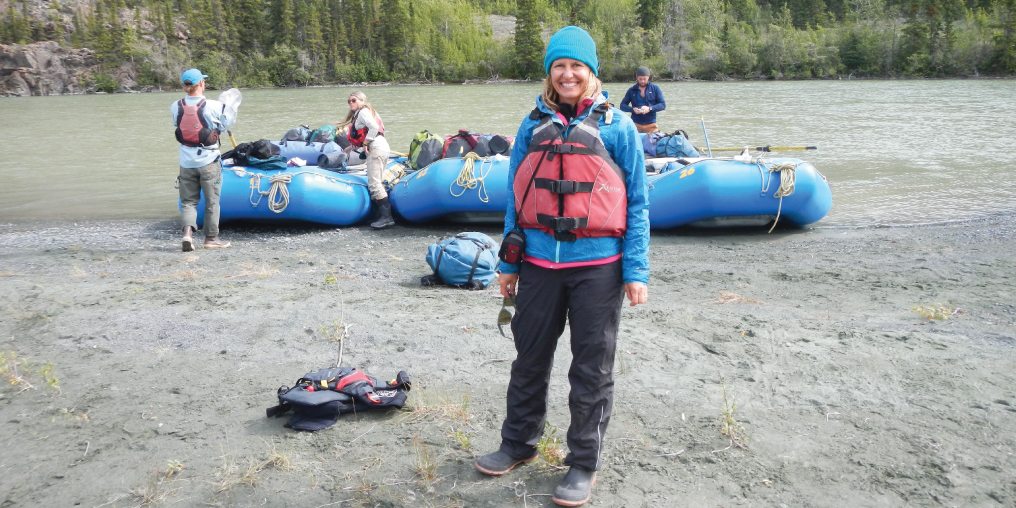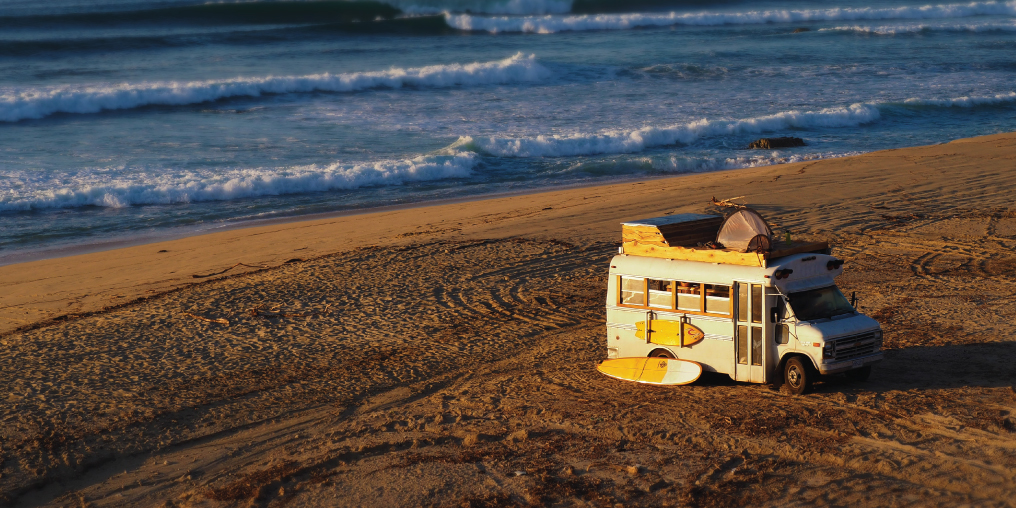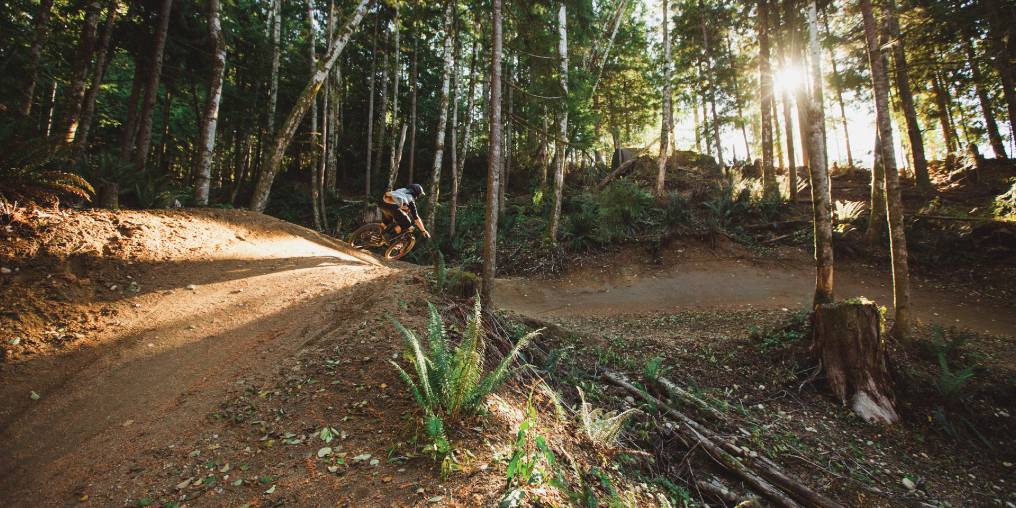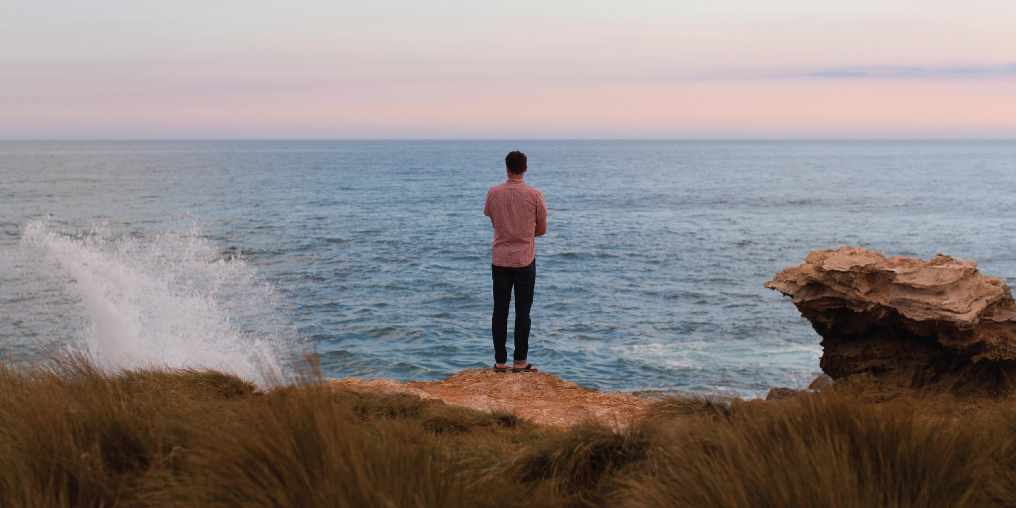In 2021, I decided to travel across British Columbia with my bike and my skis—or, more accurately—with my skis on my bike. My inspiration was the snowline—the transition mark between my two passions, biking and skiing. I planned to cycle to it, camp near it, and ski above it. Along the way, I thought, I might define my own meaning of adventure.
I often travel alone and I like it; it feels natural to me and fits well with my personality. But for this trip, I’m aiming to expand my bubble and meet other people, and I’ll ski with others where possible, for both safety and company.
FRIDAY, APRIL 16
A grassy rest area along Highway 3 northeast of Creston, British Columbia. Maps are fully open and gear is spread everywhere.
This is the moment.
The moment where a project becomes an adventure. Where thoughts become reality. Where stress and anxiety become excitement and energy.
It’s 8:30 a.m. I’m good to go!
SUNDAY, APRIL 18
At 7:45 a.m., Erik shows up on his bike at my campsite in Fernie, with his skis attached to his pack.
We ride to the snowline (1100 m elevation), then put our skins on and make our way up through a beautiful valley and into a spot that locals call “Orca Bowl.” The whole day is exactly how I envisioned this trip going—everything lines up, and the skiing is amazing.
We finish the day around the fire, talking anecdotes and future plans.
MONDAY, APRIL 26
After a week of riding through the Columbia Valley, the East Kootenays, the Lizard Range, the Bugaboos, and the Rockies, I’m pedalling up the seemingly endless Toby Creek forestry service road, headed for the Jumbo Valley, a super-natural area famous for its dramatic peaks, endless river systems, and a certain decades-long—but ultimately successful—battle against a planned ski resort.
As I set up camp at the snowline, I’m pretty sure tomorrow’s skiing is going to be worth the effort.
TUESDAY, APRIL 27
Today my companion is Jesse. We’ve planned an epic day starting at 4:30 a.m., which allows us to travel on colder, faster snow. For safety, we agree to an 11 a.m. turnaround time.
The terrain is steep, the vegetation thick, and the route isn’t obvious for us non-locals. After six hours, we’re forced to go back without having found any ski-able options.
Only one week into my trip, I’m feeling bitter. Where are those long ski descents I dreamed of? Why am I dragging 80 pounds of gear I can’t use?
I realize I need to redefine my idea of a great time, to pursue consistency instead of risk, and to use the word satisfaction instead of achievement.
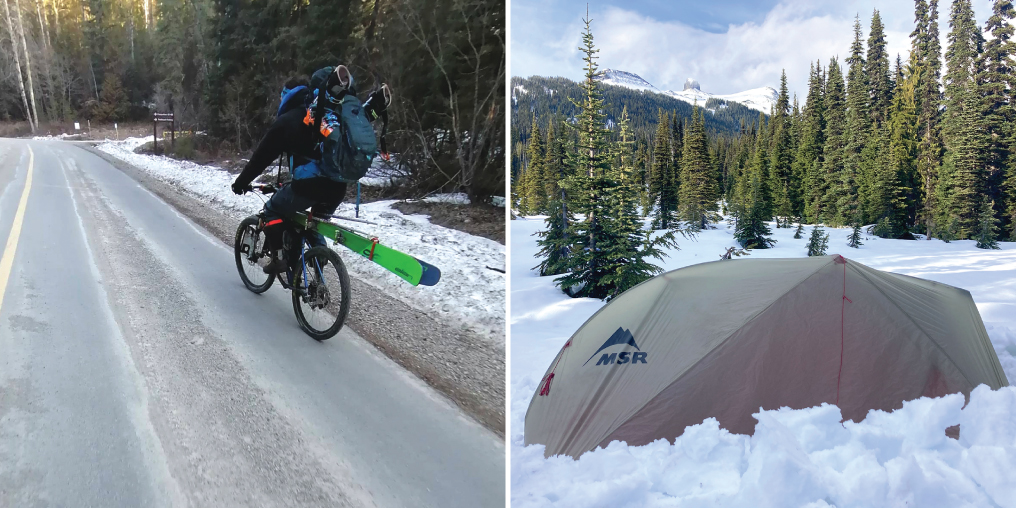
TUESDAY, MAY 4
Today I’ve got an exciting section of the Trans-Canada Highway, going from Golden and through Rogers Pass in Glacier National Park to Revelstoke. I get up at 5 a.m. and start the day with some sweet turns on the south face of Heather Mountain, above last night’s campsite. I return to find a crew cutting trees around my tent: apparently, I camped in the middle of a future clearcut. I pack up and get out.
As the kilometres pass, my pedalling is smooth, I’m enjoying the landscape, the traffic isn’t bad, and time even goes backward (right in the middle of the hill, I change time zones from mountain to Pacific!). COVID-19 restrictions prevent me from staying in Rogers Pass overnight, but as I start my descent around 5 p.m., I’m more than satisfied—I’m elated that I’ve gotten the most out of this day. This is all I need.
FRIDAY, MAY 7
In Revelstoke, I try unsuccessfully to find an adventure partner, and finally decide to tackle the McCrae Peak area (described by locals as mellow and beautiful) solo. After gaining over 1000 m in less than 20 km of riding, I set up camp at the snowline.
This morning, it takes only 30 minutes from the insistent sounds of my alarm to the clicking sounds of my ski bindings. This includes coffee and breakfast.
Going uphill is a repetitive motion, like a dance on skins, from treeline to subalpine to alpine, along a logging road network. This morning, my route is sometimes enlivened by the sight of frozen grizzly tracks. Eventually, I find the owner of those frozen tracks: a beautiful cinnamon male. He goes straight through the clearcut while I follow the snaking road; we cross paths again and again on the way downhill.
After this successful day, I consult the map. My next option for skiing is Duffey Lake, 450 km away.
TUESDAY, MAY 11
After several days of riding through peaceful farmland—the Shuswap River Valley, Mabel Lake, Enderby, Armstrong, Falkland, Paxton Valley, and Kamloops—it’s over 25 degrees and the landscape has changed completely: it’s dry, with low vegetation and even cactus. I pass Cache Creek, then Marble Canyon; I feel like I’m out of context, with a winter-loaded trailer, in the middle of a western movie.
SUNDAY, MAY 16
Lillooet! Loamy forest floor, giant cedars, and powerful rivers at the door of the Coast Mountains; the next part of my journey should have ski options at every corner: Duffey Lake, Lillooet Lake, Pemberton, Whistler, Garibaldi Lake, and Squamish.
After a long, steep bike ride up along Cayoosh Creek, I find the snowline at 1300 m at the bottom of Mount Rohr and set up camp.
MONDAY, MAY 17
When my alarm wakes me at 5 a.m., I hear dripping on my tent. It’s raining, but I head out anyway.
After pushing for three hours, I reach 1800 m altitude; I can’t see a thing, it’s now pouring, and my excitement is long gone. Enough.
I return to camp without making any acceptable turns, then pack up and start riding toward Pemberton. I’m soaking wet, my gear even more. Multiple exciting options have turned into one unsatisfying day trip of only a few hours.
WEDNESDAY, MAY 19
After a quick reset in Whistler, I head toward Garibaldi Lake. Here, the snowline is around 1100 m and I want to set up a base camp on snow directly in the alpine.
I decide to claim the spirit of each day: no peak objectives or expectations about snow quality. I’m just going to enjoy my time and be present and fully connected with the environment.
I bike, hike, and ski my way up to Taylor Meadows, where there’s an incredible view of the surrounding peaks, including two I will successfully ski over the next two days: Black Tusk and Panorama Peak.
The weather is perfect. The sun beats down during the day, but the night is still cold, which protects the snow quality: frozen early mornings for fast travel, slushy at midday for fun turns!
In camp, I slow my pace and read, journal, explore, and plan the next couple of days. I feel connected with myself.
SATURDAY, MAY 22
A beautiful spring day in Squamish. I’m not tired and I’m still motivated to ski, but I’m homesick. I decide to point my bike towards the coastline.
After a ride on the Sea-to-Sky Highway that’s the exact opposite of epic, I board the Langdale ferry at Horseshoe Bay. Riding along the Sunshine Coast won’t be the fastest way home, but my journey is about exploring this beautiful province, and even though I live close by, I rarely visit this part of BC.
Langdale, Gibsons, Roberts Creek, Sechelt, and Pender Harbour—this route is my French Riviera, and, again, my winter gear seems completely out of place!
MONDAY, MAY 24
Last night, I was lucky enough to rest under a beautiful forest canopy along a creek. On the ferry from Earls Cove to Saltery Bay, I pass clusters of islands, dense old-growth forest, and rugged coastline. The water is deep and dark here. This is my wilderness. Home is close.
My energy is high and my haul feels light as I fly along the next 25 km to Powell River and board the day’s last ferry to Comox.
When the ferry deck opens at the Little River ferry terminal, it’s completely dark. As I roll onto the land, I feel an intense flash of memories and connection with home; I even get goosebumps.
I ride home with incredible energy, sprinting on each hill, smiling, laughing, enjoying these last few moments.
The last corner, the last straight line, and finally, I’m home. I lay my bike against the stairs of the tiny home; I sit down on the patio.
It’s taken me 39 days—1,800 km and 30,000 m elevation gain—to get here.
I didn’t have the opportunity to ride all the mountains and ski all the lines I’d planned, but what I have learned is to be creative, and this is my main achievement.
I’m at peace with my journey.
